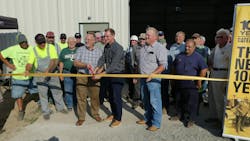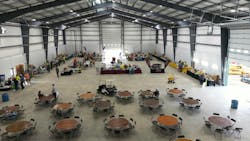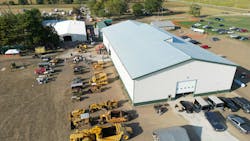Historical Construction Equipment Association Opens New Museum
The Historical Construction Equipment Association cut the ribbon on its new 20,000-square-foot museum building on September 19. The event was part of the 2025 International Convention and Old Equipment Exposition. With more than 200 pieces of equipment on site, the HCEA’s old museum could no longer accommodate the inventory.
Although the new museum offers nearly triple the space of the old, 7,000-square-foot facility, it does much more than that. The floor is heated to provide a more stable environment for the machines and a more comfortable experience for visitors. The vaulted ceiling allows shovel and crane booms to be displayed raised. The gable roof is a monitor style for about half its length on the east-facing side, allowing natural illumination to balance the lighting in the high interior.
Ground was broken on September 23, 2023, and the new museum reached a point of substantial completion in the spring of 2025 with the installation of roll-up doors large enough for equipment to be moved into the building.
The building’s $2,000,000 cost was fully funded in advance through donations. Ken Taylor, president of HCEA corporate member Ohio Cat, provided a huge boost by matching contributions dollar-for-dollar up to $500,000 during HCEA’s Big Push campaign. In fact, the Big Push effort exceeded its $500,000 goal by raising a total of $727,528.94. Taylor was also the person doing the ribbon cutting.
HCEA has plans for improvements to the building to include office and archive space and an education center, all of which will also be funded in advance of construction. The older building will continue to provide storage and shop space.
The museum is located on the HCEA campus at 16623 Liberty Hi Road in Bowling Green, Ohio.
HCEA convention and expo
The Historical Construction Equipment Association’s Convention and Old Equipment Exposition was first held in 1985 in Richmond, Indiana. The next show was in 1993 in Brownsville, Pennsylvania, and there has been one every year since except for 2020, when it was postponed due to the pandemic. Ten of the 31 events have been on the HCEA campus in Bowling Green; the rest have been held in areas that support HCEA chapters, partner with like-minded historical entities, and coincide with relevant shows.
Tom Berry, HCEA archivist and Construction Equipment contributing editor, says HCEA has around 220 pieces of equipment in inventory; another 120 or so pieces were brought in by members to display at the 2025 event. He said the numbers of visiting exhibitors’ pieces remain fairly steady, “although in times of high diesel prices that may dip.” Some decline is possible as long-time members age out of the market, but enthusiasm of following generations may well sustain the show, the HCEA, and its mission of preservation and education.
Although HCEA machines exist on a continuum of restoration, machines brought in by outside exhibitors were mostly in running order. Not only do they run, but they run well. If a newcomer to historical equipment envisions fields full of clattering, wheezing machines spewing clouds of black diesel smoke into the air, that vision is quickly quashed. This equipment is relatively quiet and clean (although some fluids make it past old gaskets and seals). It starts easily and runs reliably. The power density (power output per unit of displacement) is abysmal by today’s standards but was a giant leap forward from the mule and horse power and manual labor it replaced.
Owners of these historical machines are not content to merely display them; they work on them to keep them operable to ensure full appreciation of the state of technology these machines represented for their time.
A recent addition to the HCEA inventory is a Terex 33-15 haul truck, which HCEA says is “the last one known to exist of the Terex GM 33-15 Family.” That truck was on view right next to the new museum. HCEA has launched a fundraiser seeking $40,000 for preservation of this truck, of which nearly $30,000 had been raised as of the 2025 show. HCEA has a webpage dedicated to the history of how the Terex line emerged as the result of a 1968 antitrust lawsuit filed against General Motors by the U.S. Government.
HCEA as a resource
That research into the birth of Terex typifies HCEA, which works hard to be the single best source of information and communication for fans of old equipment. They provide searchable archives but because their archives are so vast and only a portion have been digitized, they encourage interested persons to start with the archives and then engage the help of Tom Berry in further research. Members receive the quarterly Equipment Echoes magazine and access to the digital archives of that periodical.
Aside from scale models, HCEA itself does not buy or sell anything. They do provide a platform for those who do. The Buy/Sell/Trade is one of four forums HCEA offers. The others are General Discussion, Information Wanted and Shows and Events. The Photo Galleries section is divided into five sections, including one for past Conventions and Expositions and one Equipment Identifier. Note, however, that the HCEA website is a work in progress that may return 404 errors: Page Not Found.
About the Author

Richard Ries
Richard Ries began his free lance journalism career in June, 1985, calling on his experience as a service manager at a Honda motorcycle dealership to place his first article. When the motorcycle market collapsed in the late 1980s, he moved to the booming bicycle market. Finding that market lacked the professionalism he sought, he moved to construction in 1995 and has remained there ever since.
His countless clients have included entities in Australia, England, France, Germany and Scotland. He has written for trade and consumer periodicals, equipment and component manufacturers, government agencies and non-governmental organizations. Clients have also commissioned him for photography and videography work, either stand-alone or as part of package of text and images.


